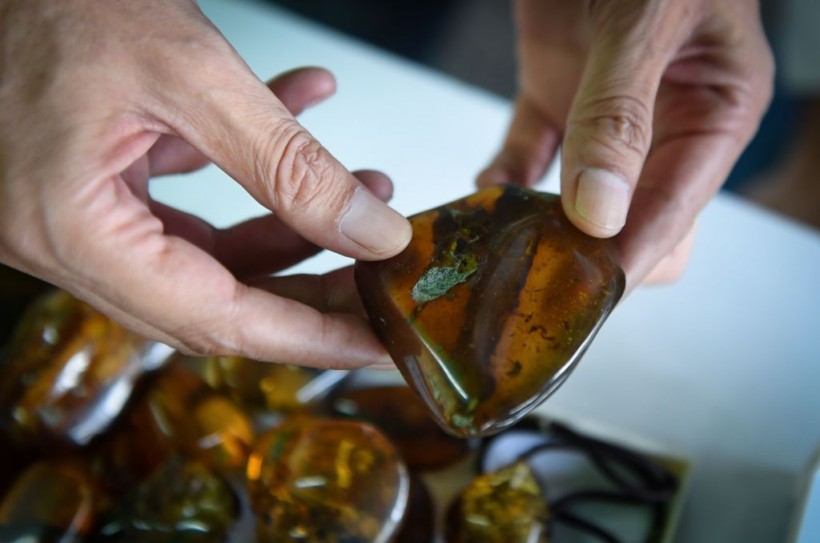Tree resins are sticky substances that ooze from the bark of some plants, such as pines, firs and amber-producing trees.
They have various functions for the plants, such as protecting them from insects, fungi, and wounds.
They also have a remarkable ability to preserve the past, as they can trap and fossilize plants and animals that come into contact with them.
These fossils, known as inclusions, can provide detailed information about ancient life forms and their interactions.
But tree resins can also reveal something else: the identity and environment of the trees that produced them.
This is possible because tree resins contain organic compounds called biomarkers, which are chemical signatures that reflect the biological origin and history of the resins.
By analyzing these biomarkers, scientists can determine the type of tree that exuded the resin, as well as the climate and vegetation of the time.
Fossil tree resins, also called ambers, are found in sedimentary rocks of various ages and locations around the world.
Ambers are considered a special type of fossil deposit, called Konservat Lagerstätten, because they can preserve exceptional details of ancient organisms and ecosystems.
The methods and challenges of resin biomarker analysis
 (Photo : LILLIAN SUWANRUMPHA/AFP via Getty Images)
(Photo : LILLIAN SUWANRUMPHA/AFP via Getty Images)

To study the biomarkers in fossil tree resins, scientists use sophisticated techniques such as gas chromatography-mass spectrometry (GC-MS), which can separate and identify the different compounds in a small sample of resin, as per Phys.org.
The resulting chromatogram shows a pattern of peaks that corresponds to the relative abundance and molecular weight of each compound.
Based on these patterns, scientists can classify the fossil resins into five major classes: Class I (terpenoids), Class II (labdanoids), Class III (abietanes), Class IV (phenolic abietanes) and Class V (sesquiterpenoids).
Each class is associated with a certain group of plants, such as gymnosperms (plants with naked seeds) or angiosperms (flowering plants).
For example, Class I resins are typical of conifers, such as pines and firs, while Class V resins are typical of angiosperms, such as legumes and eucalypts.
However, resin biomarker analysis is not always straightforward. There are several challenges and limitations that scientists have to deal with, such as:
- The scarcity and degradation of fossil resins. Fossil resins are often rare and fragmented in sedimentary rocks, making it difficult to obtain enough material for analysis. Moreover, they are subject to chemical changes over time due to burial, heating and oxidation, which can alter or destroy their original biomarkers.
- The variability and ambiguity of resin biomarkers. Fossil resins can have different biomarker compositions depending on various factors, such as the age, species, and health of the resin-producing tree, the season and location of resin exudation, the type and degree of resin maturation and alteration, and the presence of contaminants or additives. Therefore, it is not always possible to assign a precise botanical source or paleoenvironmental condition to a fossil resin based on its biomarkers alone.
- The lack of reference data and standards. Fossil resins are often compared with modern resins or extant plants to infer their provenance and paleoecology. However, there is still limited knowledge of the diversity and distribution of resin-producing plants in the present and past, as well as their resin chemistry and biology. Moreover, there is no universal or consistent classification system or nomenclature for resin biomarkers.
Also Read: Amber Reveals Ancient Dinosaur Ecology
The applications and implications of resin biomarker research
Despite these challenges, resin biomarker research has made significant contributions to various fields of science, such as paleobotany, paleoecology, paleoclimatology, and biogeochemistry, as per WN.
Some examples of these contributions are:
Reconstruct ancient plant communities and biomes
Resin biomarkers can help identify the major groups of plants that dominated certain regions and periods in Earth's history, such as conifers in the Mesozoic era (252-66 million years ago) or angiosperms in the Cenozoic era (66 million years ago to present).
They can also indicate the diversity and evolution of resin-producing plants over time and space.
Inferring past climate and environmental changes
Resin biomarkers can provide clues about the temperature, precipitation, seasonality, and atmospheric composition of the past, as these factors can affect the resin production and preservation of plants.
For example, some resin biomarkers can indicate the presence or absence of frost, drought, fire, or volcanic activity in the ancient environment.
Tracing the origin and migration of resin-bearing rocks and fossils
Resin biomarkers can help determine the provenance and age of sedimentary rocks and fossils that contain or are associated with fossil resins.
This can help reconstruct the geological history and paleogeography of certain regions and continents, as well as the dispersal and biogeography of ancient organisms.
Resin biomarker research is a promising and exciting field that can shed light on the long and complex history of life on Earth.
By using tree resins as natural archives, scientists can uncover the secrets of million-year-old ecosystems and their changes over time.
Related article: Springtail's Globe-Trotting Secret Caught in Amber
© 2024 NatureWorldNews.com All rights reserved. Do not reproduce without permission.



![Climate Change is Reducing Dust Levels Worldwide as Arctic Temperature Warms [Study]](https://1471793142.rsc.cdn77.org/data/thumbs/full/70320/280/157/50/40/climate-change-is-reducing-dust-levels-worldwide-as-arctic-temperature-warms-study.jpg)

